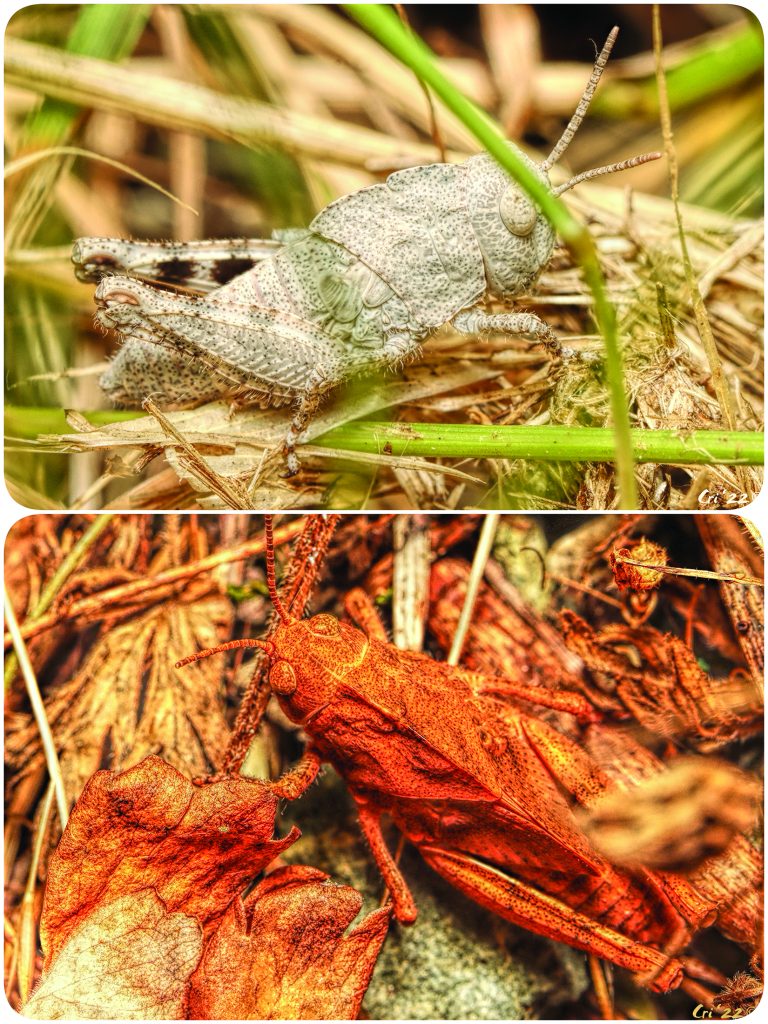
This week’s crawly will really click into place with your summer memories. Meet the Carolina grasshopper (Dissosteira carolina).
There are around 650 species of grasshoppers in North America. Despite that, it’s always easy to identify a Carolina hopper.
Carolina hoppers are one of the largest grasshoppers around. As you can see by the photos of two different nymphs from this year, they have wicked good camo and all but vanish when they’re not moving. They also range in color from rusty-brown to tan or gray. They are rarely green. Also, as you can see, they have no markings except some spotting.
Luckily Carolina hoppers are very conspicuous when in flight. These hoppers are the ones you see and hear in mid to late summer, especially in open fields and along roadways. They are the ones with large black wings with a yellow border across the bottom and it’s the Carolina males who make that super cool clicking sound in flight. The sound that is reminiscent of an olde timey cap pistol.
How the heck to they make that sound? Males pop taut membranes between their wing veins and it’s “clickety, crack!”
Before we get into the “why” of that clickety sound, lets back up a bit to some general facts about grasshoppers. They have four wings total; the top wings are leathery and shelter the more delicate flying wings.
The short wing nubs you see on our pictured nymphs can’t yet be used for flying or clicking but will turn into fully functioning wings after a few more molts.
Once the males have reached full adulthood, they’ll start their noisy and showy mating flights. They’ll fly up about three feet into the air then hover for a few seconds while “clickety, clacking” to attract females. Of course, this ruckus also attracts competing males, and the roadside or open field turns into an impromptu grasshopper house party/fight club.
If a predator wanders or flies by, the Carolinas drop to the ground and remain still. The striking change from their big, flashy wings and movement to their unmoving camouflage perfection makes them all but invisible to predatory eyes (and to photographer eyes too, they’re tricky to get photos of).
These displays only take place in the afternoon. Carolina hoppers have a scheduled day of mostly laying around, basking and eating – especially the females as they don’t have to go around trying to impress anyone.
Carolina hoppers emerge from their overnight shelters (under leaves, etc.) about two hours after sunrise. Then they bask in the sun for another few hours before meandering around their patch to grab a meal. Once they’ve eaten it’s time for grooming and resting. Then they’ll bask again in the late afternoon sun from about 3 – 5 p.m. before supper and turning in for the night.
Though Carolina hoppers can be found throughout most of the lower 48 states, they are considered only a “minor agricultural pest”. This is largely due to their wide-ranging diet and choice of habitat. Most populations occur chiefly in disturbed areas where they feed mainly on weeds.
Females oviposit (lay eggs) in dry, compact earth which gets direct sunlight. They’ll often choose the edge of a gravel or dirt road. A female will dig an approximately one and one-half inch hole with her ovipositor, lay eggs in the hole and use her feet to cover the opening with loose dirt and gravel.
Eggs will overwinter and hatch out the following year in late spring or early summer. The eggs need to warm to 77 degrees Fahrenheit for a few days before hatching.
Depending on how much sun hits the spot where a female laid her eggs, different nymphs from different females will hatch out over several weeks, so you may see teeny hoppers and see and hear flying “poppin’ hoppers” out and about now through at least September.
